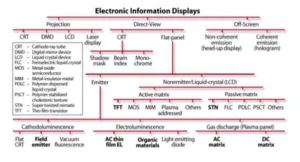The last few decades can be easily labeled as the Display Decades (DD). With the rise of LCD, PDP, OLED, LED, DLP, Laser, EPD and other technologies, we have now a wide array displays to choose from. As a side effect this gave rise to Display Daily (also DD) as the source for display industry intelligence. Since you are reading this article we seem to have at least an interest in display technology in common.

The rise of LCD technology was the first major shift in display technology since the cathode ray tube, at least if we go by commercial success. Since then, many new technologies have been trying to overturn the reign of the LCD technology with little or no success. After the defeat of PDP technology, the remaining display technologies have been, more or less, addressing the smaller sub-segments of the display market. For example DLP is a very successful technology in the projection market, yet comparing sales numbers with LCD sales shows the real strength of the LCD industry.
Source: Stanislovas Staras – Display Devices (Vilnius Gediminas Technical University)
In recent years, everyone in the industry has been looking at OLED displays as the ultimate challenger of the LCD technology. While beautiful OLED displays have been shown at every major display conference for many years, displays with competitive image quality and price have mostly been driven by LCD technology in the larger mass markets.
Right now, it seems that this is changing for the first time since LCD replaced CRT as the most dominant display technology. OLED’s are replacing LCD in smartphones at an increasing rate that seems to be driven only by OLED capacity and nothing else. After the LCD technology enabled the notebook market to take over the personal computing space, we all realized that certain display technology characteristics are perfect for some applications but not for all. Sure, display technologies need time to mature, but PDP would have never been able to enable the smartphone market for example. Some technologies are just meant for particular applications like the e-paper electrophoretic displays that are perfect for outdoor reading but pretty useless, so far, for watching full color moving images.
For some reason, everyone seems to expect that OLEDs will someday take over from LCDs and replace them in all applications. The question is if this is even a realistic expectation? Maybe OLEDs will rule the smartphone and PC market while LCDs continue to dominate the TV market? I wonder if something along those lines was in Samsung’s mind when they decided to let LG go after the OLED TV alone and focus solely on the small display market.
Anyway, we should all be set now – LCD for large displays and OLED for small ones and everything else is for smaller specialized market. Agreed?
Well this depends on the drivers behind the display technologies. The drivers for display technologies are of course products that create a high consumer demand. Smartphones and tablets have driven high volume, others not so much. There are wearables like smartwatches and of course augmented / virtual headsets that are still looking for the optimal display technologies to make them successful products with the consumers.
Both of these product categories are still searching for a display technology that allows them to create better products. In the case of the smartwatch we are seeing OLED displays today, however some are looking ahead at the use of other technologies like microLEDs, for example, to make a better smartwatches. In the case of AR and VR headsets we are somehow stuck with OLEDs and LCDs for now. However, as I said before, today we do not even know what the real requirements for display technologies used in AR / VR are. Yes, there is some discussion about refresh rates and other display characteristics, but every headset can still trigger nausea in the user when combined with the wrong content. So I conclude that we still do not know what is really required to make a VR headset that is comfortable for all users all the time. And after all the display technology improvements we can think of, it may still be a question of content.
One aspect that these new product categories have in common is power consumption. As highly mobile product categories, power consumption will always be an issue. MicroLEDs promise higher power efficiency, a real advantage when we look at the usage mode. Battery technology will get better, but so does the performance expectation for the display and processor. This race has never been won by the battery technology, so far. It makes a lot of sense that the lowest power consuming display technology should win in the long run if the image performance is good enough. This leaves the question as “What is good enough when it comes to display performance?”. That sounds like a good topic for another article.
– Norbert Hildebrand

